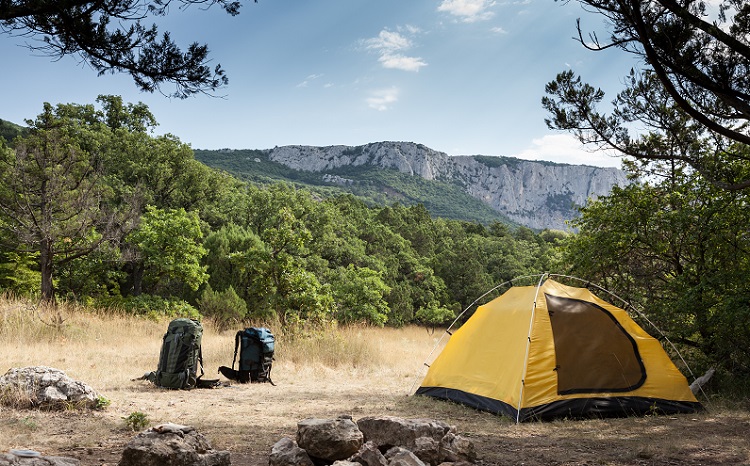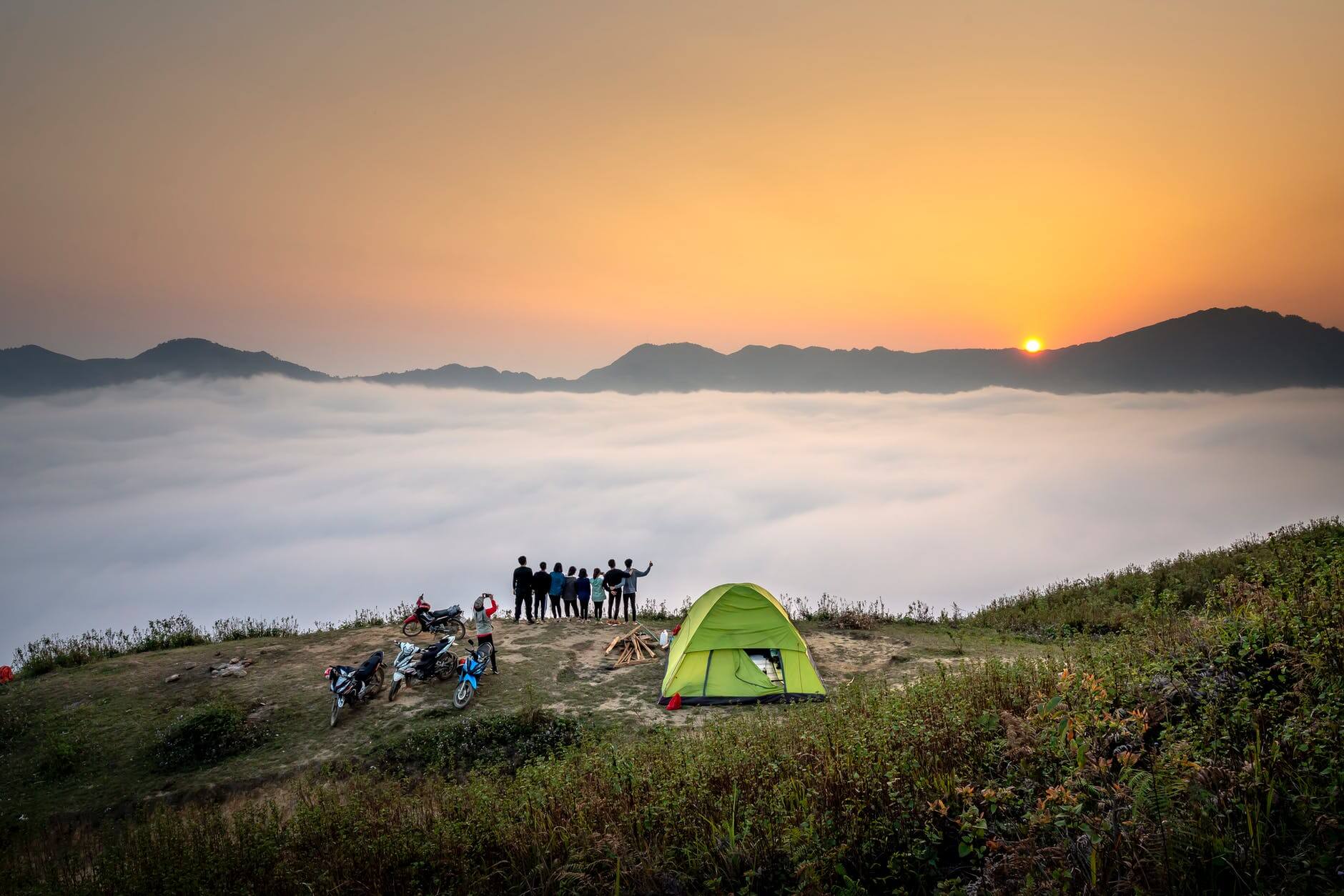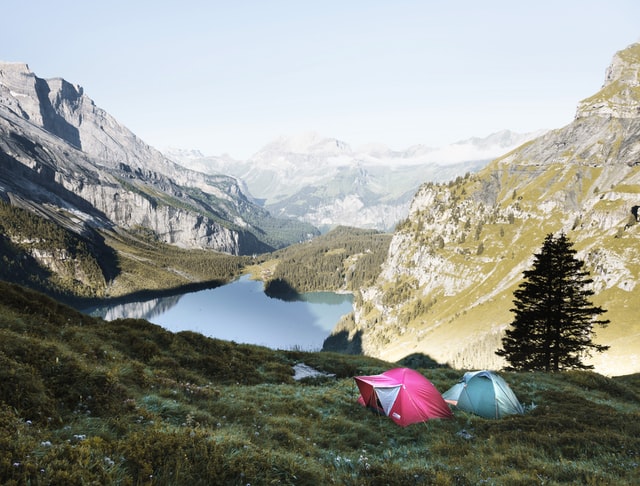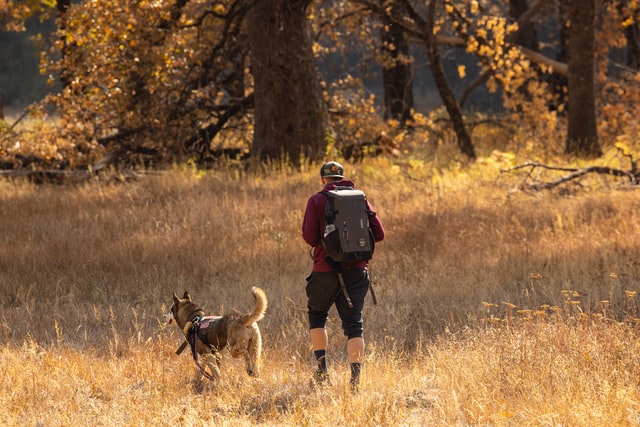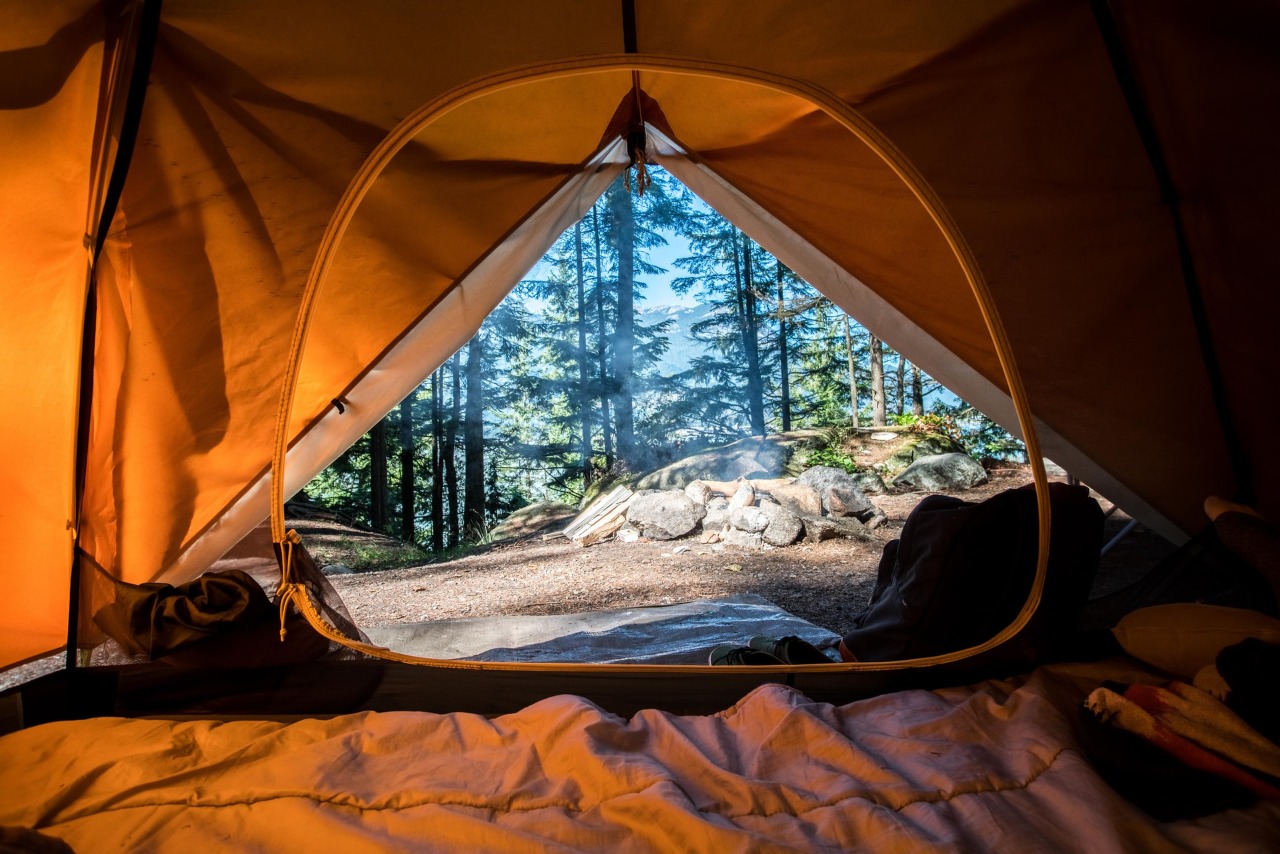
If your budget is low then don’t worry. I know budget tents are very bad and have fewer features but I found some of the best budget backpacking tent under $100 is also very good with all features.
I have tried it myself. I will show you a good budget tent. I have taken this for you best budget backpacking tent under 100 will help you everywhere you go camping easily.
With a backpacking tent, you can enjoy your camping. Here are some of the best budget backpacking tents. I would like to refer you. It will be very good for you. I will show you what you need and it will work well for you. I will give you some of the tops of the best budget tent.….
I did try it myself, then after a lot of hard work, I am telling you that these tents were the best tents in budget tents and backpacking. you will not face any major difficulty, they are mentioned below briefly with their PROS, CONS, and Main Points Final Verdicts.
I will tell you where you can use these tents for events such as Sporting Events, Parties, Vendor Shows, Farmer’s Market, Family Outings, Weddings, Grill, Trade shows, Hiking & Tailgating, etc.
Contents
If you in Hurry
Quick Review: Here are our top favorites tents. I will tell you some of the best tents this tent has experienced. My team members found some of the best budget tents for you in my article.
The tent is suggested by me because it has all the features and budget tent that a tent should have, it is easy to open and takedown and lightweight can be transported easily anywhere. 1. ALPS Mountaineering Lynx 1-Person Tent. 2. LPS Mountaineering Lynx 2-Person Tent. 3. Wakeman Family-Tents. 4. Coleman Sundome Tent.
Our Top Picks 10 Best Budget Backpacking Tent Under 100.
Need a tent? Here’s a great tent for the money! This tent is the best one for the money and it’s perfect for backpacking! With room for two adults, you and your partner can sleep comfortably without worrying about the weather. Read more here!
- Mountainsmith Morrison 2 Person Tent (Best 2 person Tent).
- ALPS Mountaineering Lynx 2-Person Tent (Best Budget Buy Tent).
- Wakeman Family-Tents (Best backpacking tent under 50)
- ALPS Mountaineering Lynx (Best budget backpacking tent 1-person).
- Coleman Sundome Tent (Best Waterproof Tent).
- Winterial 1 Person Personal Bivy Tent (Best budget waterproof tent).
- Kelty Salida Camping (Best 2 person backpacking tent under 100).
- MOON LENCE Camping Tent (Best 2/4/6/ Person Tent).
- Toogh 3-4 Person Camping Tent (Best 3 man tent under 100).
- Hyke & Byke Zion 1 and 2 Person (Best 1 and 2 Person Tent).
1. ALPS Mountaineering Lynx 1-Person Tent.
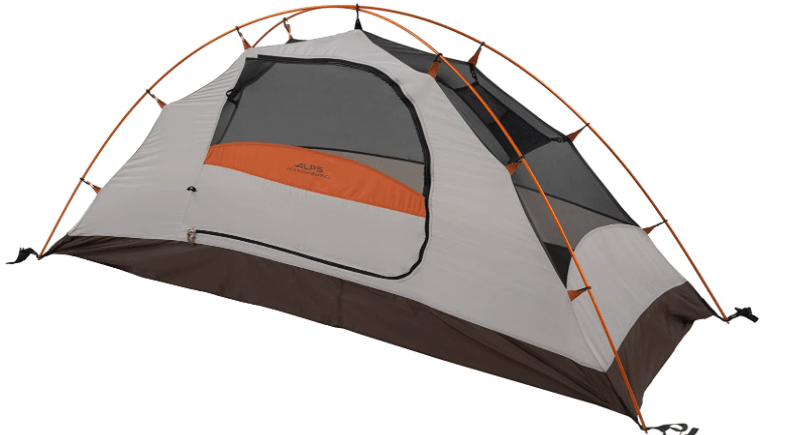
ALPS are the best tent if you are going alone camping i.e. it’s a one-person tent. It’s hassle-free.
That means you don’t have to worry about the tent assembling process because of its detached, aluminum two-shaft configuration which is a breeze to arrange. It is the best budget backpacking tent under 100.
Its manufacturing plant seals the fly and floor creases to give the best climate protection. It has a 75D 185T polyester fly which opposes UV harm away from the tent and stays tight. ALPS has an extra huge 8 zippers on entryways and vestibules.
It has one door opening and also it provides space like it has storage pockets so you can easily put your things without creating a messy tent. Additionally, it is coming with gear space, stakes, and fellow ropes.
The Lynx highlights vestibule which is offering a lot of wet-climate assurance and additional stuff stockpiling. Its assembly is easy with clips that quickly snap over the aluminum poles. Its half mesh walls increase overall ventilation in the tent.
Main points:
- It can easily handle strong rain and wind.
- It’s a long-lasting tent for one person camping.
- The tent is easy to open and can be settled by only 2 people.
- It provides protection from ultraviolet sun rays.
- The material used in this tent is 100% waterproof.
Read more: Best Camping Tents Under 200
2. ALPS Mountaineering Lynx 2-Person Tent:
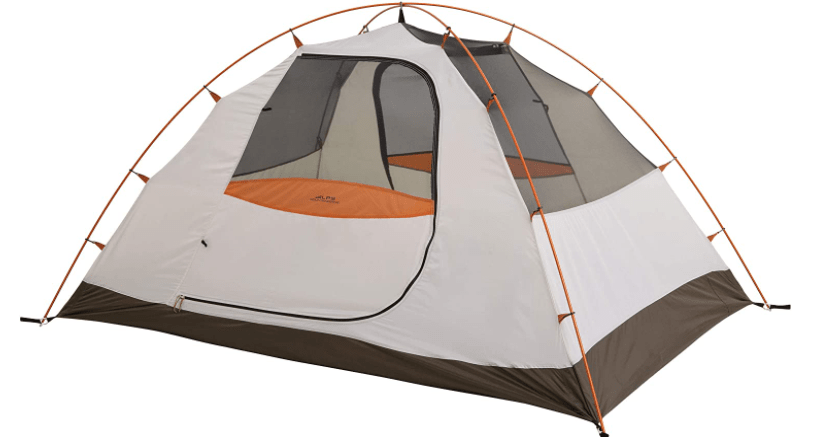
If you are looking for a high resistive best budget backpacking tent under 100 but you also want an economical thing then you are going right. This is your desirable tent.
If you want to camp in a desert or a high windy area then it’s good for you. It can withstand harsh winds. It may get you through a couple of years with the mild-moderate practice.
With 20mph winds, it can stand strong and grounded even when it is empty. Also, perform well with rain but without footprints, it is not able to keep out the moisture as well.
It is breathable, and also we can enjoy a beautiful sky full of stars while sleeping in a tent. In size, it is very small and very easy to carry.
Main points:
- It is Usable in 3 seasons.
- It has the Capability to the gear inside.
- You will be secure from Scorpion snakes and other hazards.
- It has very low weight and is small in size.
- It is easy to carry in your backpack.
Read more: Cheap Tent With Stove Jack
3. Mountainsmith Morrison 2 Person Tent:
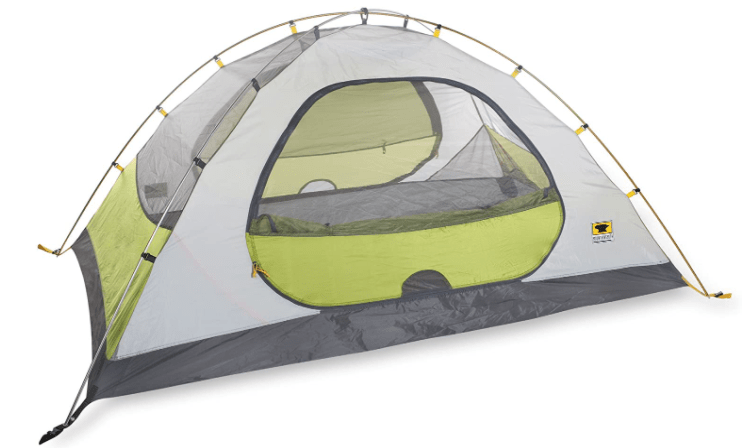
Mountainsmith is a 2 Person tent that is made up of imported polyester. It has two doors with two entrance layouts.
It’s a free-standing four corners tent with a bathtub-like floor construction. It has a mesh wall with a detachable ceiling with storage pockets.
Due to its clip pole attachment, it is very lightweight and provides better breathability. Its interior has a usable space of 35 square feet (its floor area) with the comfortable accommodation of 2 adults. It has a lock cord adjustment with reflective guy lines.
It has a 17 square feet area of entrance with a peak height of 43 inches. You can easily read its instructions which are printed on its stuff sack. Its attic is removable so you can set it according to your own choice. It is highly recommended if 2 people are going camping.
Main points:
- It has enlightened ropes. The light ropes that accompany it light up like Christmas lights when you sparkle your headlamp on it. Makes it truly simple to detect the tent from a long way away.
- It is well ventilated i.e. it has netting on all sides of the tent which permits a lot of wind stream.
Read more: How much should a backpacking tent weigh
4. Wakeman Family-Tents 2-Person Dome Tent:

This is my fourth product in our list of best budget backpacking tents under $100 manufactured by Wakeman. The tent uses high-quality Material 190T polyester and uses strong fiberglass poles.
Dimensions are (L) 77” x (w) 57” x (H) 40. The Pole diameter is 3mm. The Carry Bag is (L) 23” x 4” in diameter. Weight is 2. 75lbs. can easily fit 2 people. The color is Orange.
This tent is Make your camping adventure memorable. can sleep in the tent 2-person easily shaped like a dome with a large D-style door to adjust you and your friend tent by Wake man outdoors. The tent has a removable rain fly. It’s a good ventilation system to breathe good from nature. It has storage pockets to manage your stuff and clean your tent.
Can easily adjust Two-person in the tent. It is very lightweight and easy to carry if you move anywhere. Easy to set up only 1 person. It is fabric not waterproof to be careful in the rain.
This compact and lightweight two-person tent have the right combination of features and simple operation for hiking, camping, outdoor music festivals, and shelter while at the Beach.
Main Points:
- It is Two people tent that has enough space for you and your friend.
- It is lightweight and easy to move easily.
- Easy to set up with the help of only 1 person.
- It has a good ventilation system to breathe from nature.
5. Coleman Sundome Tent:
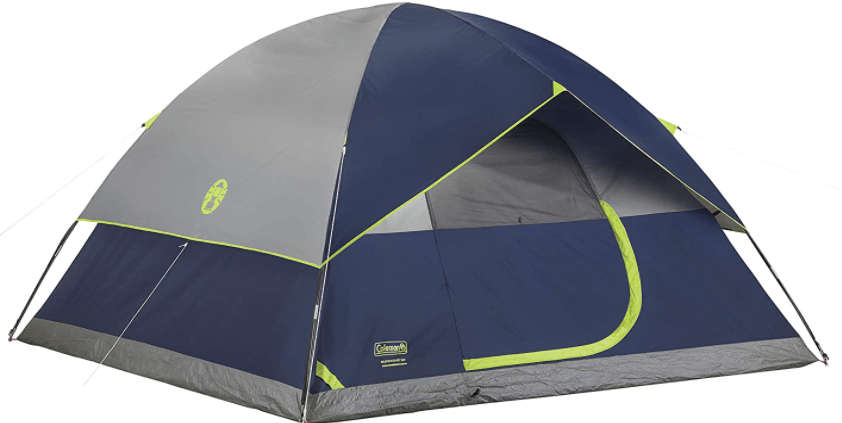
From all the Coleman tents this Coleman dome-shaped tent is very good if you are just starting camping.
It is a very good tent for beginners campers and if you find the best budget backpacking tent under 100 then a suitable budget and also for solo campers and car camping.
This tent has an exclusive weather tech system that highlights licensed welded floors and upset creases while the tough casing with Insta-Clip post connections confronts 35+ mph winds with flexible Variflo wind current ventilation that will help you to stay dry in the cozy weather.
Its rainfly is coordinated with an entryway shade to help hold the downpour back from getting into the tent. And the tough Polyguard 2X twofold thick texture is intended to withstand the components for dependable use for significantly more than one season.
This sundome tent is very spacious that you can easily use a king-size mattress in it along with that it has a good gear storage space which helps you to stay organized while camping.
Main points:
- It comes with an E-port that makes it very easy to bring electrical power inside the tent.
- It’s very spacious and the center height is 48 so it is very good for tall people as well.
6. Winterial Single Person Personal Bivy Tent:
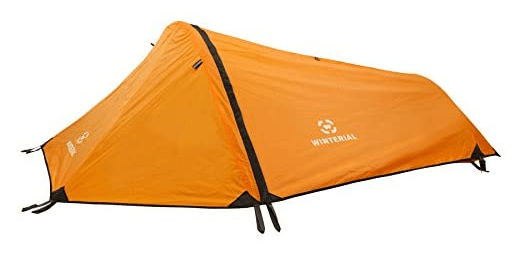
The Winterial Single Person Tent is ideal for three periods of outdoors and hiking. These three-season tents are for summer exploring and different exercises and offer more outside netting, explicitly intended.
This Premium tent element pre-fixed crease and a tough fortified downpour fly for improved waterproofness.
Perfect for a decent warm summer night with no fly and incredible for the breezy stormy evenings with the downpour fly safely connected.
Main Points:
- It is a single-person Tent.
- It is easy to set up.
- It is best for the summer season.
- It is just set up in 5 minutes by a single person.
7. Kelty Salida Camping and Backpacking Tent, 2 Person: Best 2 person tent under 100
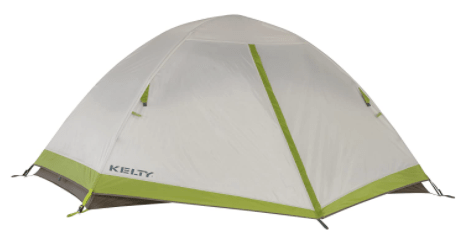
Take my after contemplations as a primary concern when buying this, yet genuinely I feel it is probably the best item that you will own for outdoors.
For one stage up in quality, you’re taking a gander at about $200-300 dollar cost increment. However long you’re not outdoors in freezing conditions, this tent will be all that you require.
Kelty tents can be used for backpacking as well as camping. The Salida 2 man hiking tent is incredible for what it’s worth, it is a very lightweight outdoors tent, and the Salida 2 has more than 10 sq. ft. of vestibule space and an extensive inside that offers 2 hikers an agreeable backwoods escape.
It has a detached plan with DAC press-fit posts and has a shading-coded cut development 2 shaft plans for a speedy and simple arrangement.
Main points:
- Its vestibule is large enough for shoes and rucksacks.
- You can use it to make espresso by setting the fly bubble up.
8. MOON LENCE Camping Tent 2/4/6 Person Family Tent:
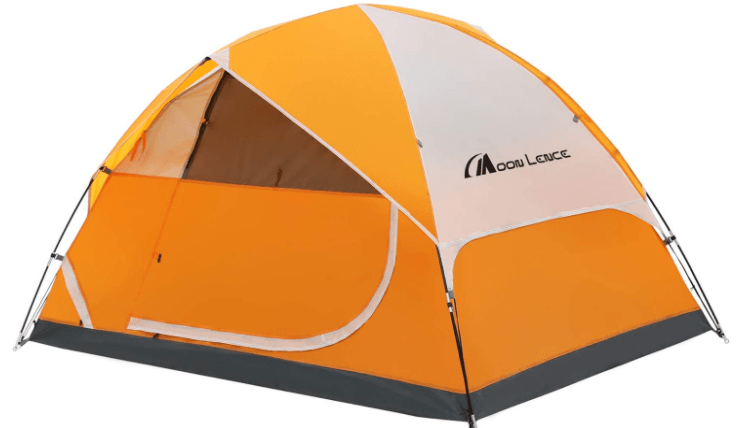
Moon lence is the best budget backpacking tent under 100 for a family. It is made from 100% pure polyester. It is very spacious, that is it is very roomy for 4 people.
This tent is very lightweight and very easy to carry anywhere. It can be easily stored in the carry bag so you can take it with you.
Moon lence is completely protected from all sides as it has 190T PU, provides water resistance from 1000mm rain, and keeps you protected from ultraviolet radiation also.
It is a double-layer tent with an equipped rainfly that allows it to easily stand in harsh weather conditions. Its doors are D-shaped with dual zippers and a large mesh section.
There are two windows in this tent which provide great ventilation and keep the inner atmosphere pleasant and comfortable.
It is extremely stable and durable as it has 9 iron pegs and 4 guy ropes that help this tent make it highly resistant to strong winds and make it more secure.
There are 2 shock cords connecting poles with clips which helps this tent to easily set up in a few minutes so that even only one person can easily set up the tent.
You can hang a little battery lamp on the implicit snare for evening lighting. Using expertly tried top-notch waterproof fabric it keeps the air inside the tent new even on soggy and hot blustery days. A solid bar is joined to the rooftop covering in 2 eyelets and fixed in the center with lace.
All things considered, the tent is sewn clean, nothing stands out and the creases are fixed with a straightforward tape within. So it can’t get wet from the downpour inside.
Main Points:
- It is extremely waterproof and keeps the tent dry and comfortable.
- It has a great ventilation system.
- There are small pockets for extra storage.
- It is very lightweight and durable.
- Except for cold weather it can be used in 3 seasons.
9. Toogh 3-4 Person Camping Tent:
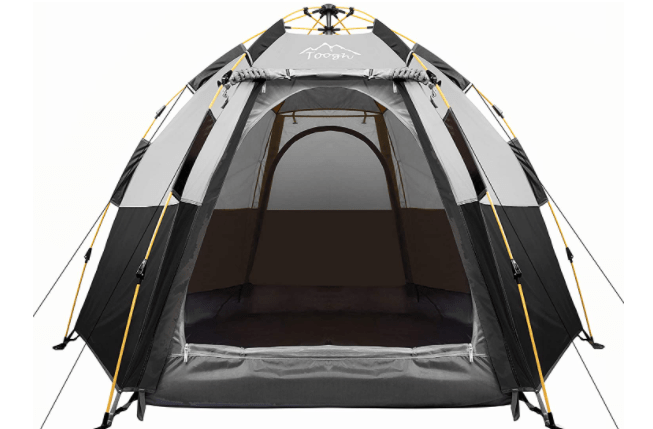
Toogh has an imported 210T oxford material. It uses oxford clothes with fine artistry. It is an exclusive patent. It is one of the best instant tents which are super easy to set up and just set up in 60 seconds.
Just lift the highest point of the unique design tent and it will program establishment and just press the finish of the shaft at second which posts have yellow names and have naturally collapsing tent.
It has an outside tent that has a waterproof level of 3000mm with silicone coating which protects it from water.
Tough provides you with complete customer support and 12-month satisfaction with the complete risk-free purchase so you can easily purchase it without any tension.
It is completely bugged and mosquito-free and protects us from mosquito bites and gives us complete ventilation.
It has 2 doors that open easily and has six angle designs that help provide more stability in rainy and windy weather and easily adjust for four people.
After lifting it, you need to nail down the corners with 6 stakes, it’s quite reasonable to add 8 person lines to it to add steadiness and wind opposition, in the present circumstance, it can oppose 15 mph wind.
Main points:
- It is set up in just minutes i.e. a mature camper sets it in 1 minute and a beginner in 5 minutes.
- This tent is very spacious i.e. its structure is completely hexagonal and has a large internal space at the bottom.
- It is completely water-resistant.
- It is very light weighted and easy to carry.
- It is very sturdy and durable.
10. Hyke & Byke Zion 1 and 2 Person Backpacking Tents

This is my tenth product on our list. It is a tent manufactured by Hyke & Byke. It is a backpack zipper orange, blue, forest green, lime green, in the color tent.
It is a Dome-shaped tent. It can accommodate up to 2 people. It is an exceptionally lightweight tent as its weight is only 3.8 pounds. Its floor width is 55 inches.
The most important feature of this tent is its fabric. They gave a lifetime warranty on the fabric. I like it. I personally used this tent to use high-quality material and a large number of audiences test this tent and are very satisfied with this tent.
It is quite easy to set up. It is a dome-shaped tent for heavy rains. It can accommodate 2-persons. It is waterproof and extra roomy. So, it is the best budget backpacking tent under 100. I will recommend that you go alone or one of your friends or family camping tents is for you.
Main points:
- The tent is giving a lifetime warranty.
- This tent easily fits 2 people with gears and other stuff.
- In this tent are special features to protect from the rain.
- It also included a Rain-cover, Portable, Windproof, Waterproof, Ventilation which gives extra weather protection, safe your gears.
- Time-saving quick setup in a few minutes.
- It also has a two doors adjustable very comfortable tent.
- It also worked in rainy and stormy weather with a group of friends or family.
- There are also storage pockets that keep your gears organized on the floor.
- This tent is set up easily for only 2 people.
How we chose the best backpack tent.
My name is Saud and I led this whole review. I have been backpacking for the last 25 years and also working as a field guide where I spend months and months living outside the tent. Outside, I inspect 20-30 tents each year during the summer buyer’s guide and have probably experienced over 100 tents in total.
For the buyer’s guide, I set up each tent myself and ran each one through a series of tests in my garden. I spray them on the hose, bring them out in the face of storms and rains, climb in and out, and even work on my laptop from the inside. Each store also does camping for real-world testing. I take most of them, but I also introduce some other testers who take them on family canoe tours and several weeks of expeditions. At the end of the test period, I gather all the feedback and compare the specifications. Then I pass on my findings to outside editors, who also make a living and check stuff all the time. Together we choose the best tents each year.
Then there are tests. I want to see how our favorite tents stand up to years of use and abuse, different environments, and the constant pace of innovation. I also see what other people are saying. By reading reviews from online comments, Backcountry.com, REI.com, and other sites, and talking to retail staff and other professional gear reviewers, I see how my choices compare.
As I review the tents for the magazine, I’m looking at the latest releases so I can keep up with the latest developments. For the review you are reading now, I have selected the best performing tents for specific categories: two-person, one-person, rainy season, etc. Don’t worry if the tent is new. What I am proposing here is the best tents, period. Even if they are a few years old, I think these tents still outperform new competitors.
To make sure my reviews are up to date, I went back to my notes, looked at all the suggested stores, and slept in each one again. I also left them in the rain and wind, put them down again, laid out a couple of air mattresses and sleeping bags, and played cards with my daughter to measure the width. Then I packed everything, checked with my editor, and started writing.
Store maintenance
Backpacking tents can be expensive. You want them to last as long as possible. Take care of your tent and it will take you years of adventure. Here are some suggestions on how to look or get an appointment for tattoos.
Washed
Sometimes your tent gets really dirty after the trip or it’s been on very short trips and it’s time to clean it up. Salt, mud, and dust can break down fabrics, siding, and posts over time.
Most of the time you can do light cleaning with a soft garden hose. If you need more than that, a mild soap (not soap or another strong cleanser) and a soft sponge will do the job.
Never wash it in a washing machine or dry it in a cloth dryer. They are too rough for the delicate clothes in the store.
After washing, make sure it is completely dry before storing.
Protected
The most important thing to remember when storing a tent is that it should be dry. Mold in the damp store will start in 24 hours. Moisture can break waterproof fabrics and coatings, giving you a sticky, peeled tent.
Set up or hang your tent to dry completely before removing it. Do not leave it in the sun for too long, as UV rays will start to break the waterproof canopy.
Once dry, wrap it in a canvas bag and store it in a cool, dry place. Try to avoid repeating the tent on the same fold lines. This will increase the wear in these small areas.
Sealing of tents
Raincoats and tent floors will be waterproof, to begin with. With time and use, coatings will fall off and you may feel leaky. You can seal these leaks with spray sealant or paint. Some tents are waterproofed with polyurethane and some with silicone, so make sure sealants or screws work with your tent fabric.
Other types of shelters
Tents are not the only shelter option on a backpacking trip. Some of these shelters may be lighter than tents.
Tarpaulin
Tarps are one of the most flexible shelters you can get. Depending on where you are and the weather, you can choose to ride them in a variety of ways. Trees, paddles, or trekking poles are the best helpers to support the canvas. Some come with tarpaulin mesh and waterproof bottoms which make a very tent-like structure, but most do not. Weight gain under mesh and waterproof.
(Coming soon) Don’t forget to check out the Backpacking Canopy Guide for more information.
Floorless tents.
Floorless tents or canvas tents are halfway between the tents and the hiking tarps. They are supported by tent poles, trekking poles, or trees and are often barefoot to save weight.
Without the floor, you have to choose the place to camp carefully. You will be fine during the dry season, but if it is raining, you can stay awake.
Setting up a tent without a floor on the ice means you can dig the ground below. It gives you endless options to climb.
Hammocks
If you want to get off the wet ground, swings are the best option for shelter. Large cotton swings with heavy wooden spreaders are no longer used for backpacking, but many models are now made of a lighter material.
Camping hammocks have an insect screen and a canvas to keep critters out, keeping you and your gear dry. They do not offer as much indoor space as a tent, but they can be very comfortable. There is little space inside for gear, but most of it needs to be stored outside, where it is hung. As long as you can find the trees, they are quick to install.
Camping bag (BIVY)
Bivouac bags are tight bags that fit you perfectly. Some are waterproof. Some have a small stick to hold the fabric out of your face. Ventilation can be a problem if you turn them off all the way. If you only need a dry place to sleep at night and then go out in the morning, they are very light. You can also use them to increase heat and reduce humidity under tarps or under tents.
Buying Guide:
What should you know before buying a backpack tent?
Imagine the spectrum of tents lined up according to size and weight. At one end you will have very light shelters. These delicate, minimalist purples are like rain jackets for your sleeping bag.
They’re designed to shave ounces, usually at a comfortable price, and are popular with people like hikers who want to travel light. Spending the night in one means being intimate with your partner’s tent. At the other end of the spectrum are car tents.
More attention is paid to indoor space and comfort in homes. They are heavy enough to carry over 100 yards, have serious bag space, and often require teamwork to set up.
A good backpack should fall somewhere in the middle of the tent. They are compact enough to carry on your back for miles, but are made of stronger fabrics than ultra-lightweight tents, and have more square footage and elbow room. And they also come with small pockets. Compared to RV rooms, backpacking tents are smaller, lighter, and easier to set up. These are versatile tents designed for adventure.
Of course, there are different types of backpacking tents. We recommend double-wall styling. These usually include an indoor tent body made of insect-proof mesh or lightweight nylon and a waterproof outdoor fly.
The space between the body and the bee encourages the flow of air so that moisture does not accumulate inside. And if the bee becomes thick inside, the space prevents sleeping bags and clothes from getting wet. Listed below are our favorite double wall-style tents.
In a wall tent, the body and the bee are the same. Removing the mesh reduces the weight, but tents on a wall get warm and thickening can be a problem. This style of tent is usually specific to mountaineering. A third style combines the two in a hybrid design. The best of the two can be used to make the best tents, like our favorite backpacking tent, Sierra Designs Flash 2.
How to choose a tent?
We believe that there are seven important things to consider when buying a tent. Everyone weighs these aspects differently, but it’s good to know them all.
Storage capacity
One of the first questions to ask yourself before buying a tent is how many people does it need to have? If you were two we would suggest vacating or buying a three-person tent, etc. But nowadays, tent designers have found unique ways to add extra elbow room without adding weight, which is why we now recommend buying a two-person tent for two.
The exception is when you are camping alone or with children and dogs. Solo campers can buy a one-person tent, but we often prefer two lightweight shelters for extra space and minimal weight gain. Campers who have children or dogs should consider a small body as an adult body size to ensure adequate space.
Two adults with a child, or two adults with a dog should buy a tent for three people. Two adults with one dog and one child, or two adults with two children should buy a tent for four people. Larger groups should consider splitting into smaller tents.
The best way to determine if this is a good fit for a particular tent is to climb the demo model. If this is not an option, you need to know a few things about how manufacturers describe tents. First, your standard two-person tent should have approximately 30 square feet of indoor floor space. Some tents will be a little longer. If you are over six feet tall.
And a new category of tents called “plus-size” or extra volume, add extra space and headroom to stay in one room without overweight penalty. The maximum ceiling height averages 42 inches. For most people, sitting without a brush is enough. Other things to look for: Pillar structures that make up vertical walls, especially cross poles, multiple poles and pre-bent or “bent” poles that make up vertical walls, and store gear outside the store. Long spikes and large vestibules to do.
However, none of this data alone tells you what it’s like to walk, play cards, or wear a pair of pants in a tent. To understand that measuring usable volume requires difficult variables – aka code NEMO, Marmot, Sierra Designs, and SlingFin have tried to better measure and show this NEMO, but we can still see if possible. If so, we stick to our recommendation to enter the tent.
The weight of the tent
Weight is often the most talked-about variable. It’s easy to adjust and you’ll notice it every step of the way. But there really isn’t much difference in the weight of today’s tents. The lightest backpacking tents usually weigh less than two pounds per person, while the cheapest tents usually weigh less than three pounds per person. This is less than a fuel bottle or the difference between an empty water bottle and a half-filled bottle. It’s not much.
Caution: When comparing weights, make sure they are apple to apple. Tentmakers often list more than one weight per tent. For example, they will list minimal, packed, packed, trace, max, etc. This weight is measured slightly differently. For your reference, all the weights we have listed in our proposed tents were recorded using our own Park Tools Bike Scale, and these weights include tent, fly, luggage sacks, and eight pegs. Are
Store price
We think this is a lovely place to backpack tents in the $ 200 to $ 500 range. $ Tents less than 200 are heavy, not very durable, often lacking in bees so they do not have vestibules and they come with suspicious waterproofing. Above $ 500, the return reduction law applies. With a few exceptions, these expensive tents use expensive fabrics and materials that will not significantly affect your backpacking experience.
Within this range, you will notice differences in weight, quality of materials, and a number of features. Up to $ 500, the tents will have enough pockets, vents, multiple peg points, high-rise construction, vertical walls, two doors, and two vestibules, and still weigh about two pounds per person. At $ 200, tents will be heavier or weaker, come with fewer features and less elbow room, and will probably have only one door.
Size
Once you know how many people you want to fit in your tent, one, two, or more, you can minimize the space you need inside.
Small two-person tents can be very tight for two people, but they make a spacious one-person tent. The size of your mat and how close you want to be to your tent mate will affect how much space you want inside. Tall people will need big tents. Having more luggage or expecting to be trapped in a tent in bad weather is also a good reason to have more space.
To see the real numbers, you would have 1.3 to 2.2 square meters for a one-person tent and 2.4 to 3.2 square meters for a two-person tent.
Station rating
Tents are categorized into seasons (or seasons) to incorporate these features. Tents with thicker fabric and more poles will be stronger and more weather resistant. They will be heavier and heavier. The best backpacking tent under 100 would be one that suits the weather and climate where you intend to use it.
3 seasons
The 3 season tents are for the spring, summer, and autumn seasons. They are made with a lot of mesh and only a few light poles to stop the rain. The purpose of 3-season tents is to be lightweight and packable. They do not tolerate heavy snowfall and severe weather. These are the most popular backpackers.
3.5 stations
3.5 station tents will have stronger poles and less mesh than 3 station tents. They may have solid panels that cover the mesh in winter and open in summer.
4 seasons
4 Seasonal or winter tents are the strongest and most weather-resistant of all tents. Strong poles support the load of snow from above which is flattened for 3 seasons. The low mesh keeps heat inside. Smaller vents help reduce thickening. Season 4 tents are heavier than others and can be difficult to thicken due to low ventilation.
Think about the type of season you will be packing and choose the right tent for it. You can use 3 season tents in the winter, but keep in mind that they can fall in heavy snow or storms.
Single or double-wall
Tents are classified as single or double-wall. Double-walled tents are the most popular, with an inner layer, often with mesh and fabric sections and a waterproof bottom, and then an outer waterproof layer called a rainfly (you call it a rainfly). Can also see). Single wall tents have only one waterproof layer. They are usually made of breathable fabric and may have ventilation holes to reduce thickening.
Most big tents will be double-walled. They are less expensive and easier to use. Some can be installed without a rain umbrella to see the stars or with only umbrellas and poles to save weight.
Packing capacity in the tent
All tents are heavy, but the smaller the pack, the more chocolate and whiskey you can bring. Or, with a well-packed tent, you may be able to carry a smaller volume pack, which helps you lose weight. Tents vary in size, but most two-person tents should be packed in cylinders about 20 inches long and six inches in diameter.
But don’t just look at the full size of the tent, consider the length of the poles and the size of the luggage sack. Small pole parts are easy to store inside the pack. Sacks of compact goods look great in the store but can be difficult to close, if not impossible.
We like that Celtic shortened the poles and switched from a cylindrical bag to a cube-shaped bag for the Trail Logic TN2 tent to suit its budget. MSR uses string-style webbing for some of its tents, including the Access 2 and Hubba series, to make filling easier. These innovations are a big deal because a handily packed tent will get you on the road faster.
The durability of the tent.
High-quality material makes the tent last longer. But high-quality content also adds value. Fabric and poles are the two easiest to understand in terms of strength. Tent manufacturers use many different types of nylon, mesh, and polyester on the body and fly.
In general, the heavier the denier, based on 9,000 yards of yarn, the stronger the fabric. But you should only compare denial between one type of fabric because each fabric performs differently.
Most backpacking tents use aluminum poles, which are usually made of DAC or Aston. Sometimes the quality of aluminum is also indicated. It is usually 6,000 or a little stronger than 7,000. Some high-end stores use carbon fiber poles. These lines are light, thin, and strong, but are more difficult to repair if broken.
Three other metrics to keep in mind: the number of stitches and the quality of the zipper and strap.
Shape
Dome tents are the most popular type of backpack tent. They are simple, easy to assemble and have plenty of space inside. The poles are on one side of the tent and the outside is lined with a waterproof canopy.
Some stand without help and some do not, they need to be plowed or braked with small ropes to keep them upright. Their round shape makes them good for high winds, as long as they are anchored. If the wind changes direction at night, the sphere becomes smoother on all sides.
Geodesic tents are large dome-shaped tents. They use more posts to build a stronger structure. You see them often in winter campaigns because of their strength and wind resistance.
Tunnel tents are not so common. They are easy to install. 2-3 U-shaped posts form tunnels. Tunnel tents should be set up at both ends to keep them upright. They may have difficulty colliding with the air around the tent because of the vertical surface. To avoid the problem, you need to find a small hill or mound cover, one end of which points to the wind.
A-frame tents are still less common today. Some tarpaulins or tarpaulins are introduced as A-frames. These are simple shelters to set up, requiring only a stick at each end and a torp at the top to form a triangle or “A”. Their A-shape makes them slide nicely through the snow but they can be pushed by the wind.
Autonomous or with anchors
In an effort to make some tent models even lighter, the designers have removed everything they could. This includes the poles and straps that make up the tent itself. This is great when you want to lose weight. The downside is that it can’t usually be staked without being tied to the ground in some way. It is easy to set up a tent on soft ground. On the other hand, it is more difficult to pitch a tent in solid wood or rock the floor. Some semi-free standing tents only need to be anchored at one end.
Floor tarps
Tent floors are durable and waterproof, but they can wear off over time. Once it’s starting to leak or explode, it’s usually time to start looking for a new store. You can use a floor tarp to extend the life of the floor.
Ground tarps are an extra piece of fabric that is placed on the ground before the tent is pitched. You can use a piece of lightweight plastic to protect the bottom, but these tarpaulins are exactly the size of the bottom of the tent and are attached to the poles in the same way as the body and the rain umbrella.
Having a ground cover allows you to get started in a quick and light setup that you will see below.
You can also find it as an image for its literal translation from English.
Fast and light assembly
Carrying a tent body, tarpaulin and groundsheet can take up a lot of space in your bag. When conditions permit, you can use the Quick & Light setup method to lighten this load only on the groundsheet and rain canopy. The tent company MSR calls it Quick & Light. Other manufacturers have different names.
To do this, spread the groundsheet, mount the pole as usual, and then apply a tarp from above, leaving the body section. Below this and the body net comes out, meaning you do not have to carry extra weight. It also means you don’t get protection from the water or the bugs it provides.
The following video shows you the final result. The Quick & Light mounting method allows you to remove parts that you can do without allowing you to choose to mount.
Ease of setting up
There is nothing more frustrating than re-positioning a tent pole at the end of a long day or, worse, misrepresenting and restarting the tent. Things that make the setup quick and easy include: color-coded poles, grommets and straps, symmetrical design, simple pole structures, and poles attached to the vestibule instead of the tent.
The easiest tents are domes or A-frames. With only two or three straight poles, they are simple but a trading elbow room. On the other hand, multiple confinements and pre-bent post structures often confuse the first hour of your configuration, but get more space.
Most tents use a two-tiered structure, where the poles are attached to the body of the tent, and then the bee is attached to the top of the tent. The fastest tent style is where the bee and the tent are connected and the poles are attached to the outside of the tent bee. This eliminates the installation phase and keeps the inside of the tent dry when set up or unloaded in the rain.
The way the poles are attached to the tent is also important. Very few tents now use sleeves because pushing and pulling the poles through the fabric tubes often results in the poles breaking or falling off. Instead, clips are now standard and what we recommend because they are fast and secure. The joint, where the poles join the tent, can range from a simple ring to a ball joint system that breaks together. The latter is good, especially for solo setups, because the pole doesn’t pop up unexpectedly.
Free-standing tents are great: Once set up, they stand free-standing without the need for pegs or ropes. They are easy to configure, even yourself, and can be picked up and moved. Free-standing tents should be supported and at least some, if not all, ropes should be used to tension the walls. With fewer posts, they are less expensive and lighter, but require more handling and sometimes someone else’s help.
Store Features
The tents are quite basic, but with some built-in lighting such as Big Agnes Rattlesnake SL3 Mtnglo, and Big Agnes Krumholtz UL2 MtnGlo comes with their own lighting, solar power, battery bank, and fan.
Note that such features add value, so consider what amenities you really need. We think it’s worth paying extra for two doors, two vestibules, multiple pockets, two-way zippers, and a fly vent to help with the wind. Go to your fly to harden it and get better performance in wind and rain. Tip: Reflective man lines help prevent tripping in the dark.
A new trend is to look at bees or tent bees through the eyes of the stars that do not need to land, but they can partially retreat so that you can see the stars through the tent net. The screen pocket is another new feature we love.
These pockets are usually on the roof and are designed to hold headlamps and spread their light throughout the tent.
And finally, there are your prints. These are groundsheets that are placed under the tent and protect the tent floor from dirt and tears. They are usually an addition and we do not consider them necessary. However, they will extend the life of the tent.
After my best research of the best budget backpacking tent under 100. I hope you will enjoy reading this article and it will help you buy your tent. The best tents for a Budget Tent. our top best suggestion.
FAQ’s
How Much Does a Backpacking Tent Cost?
A camping tent is the most important item for a backpacking trip. It provides you with an easy, secure, and comfortable place to sleep for the night.
In order to find the best backpacking tent, take a look at your destination, budget, weight, and material. It is always best to purchase a new tent rather than to rent a backpacking tent because you will want to make sure that it is durable and waterproof.
If you are looking to purchase a backpacking tent, you need to make sure that the tent you are planning to purchase fits your budget. Backpacking tents will cost anywhere from just over $100 to just under $400. It is best that you find a tent that is inexpensive but is still durable.
Should I Buy an Ultralight Tent?
Ultralight tents are a great choice for the modern backpacker because they reduce the load you have to carry significantly. Ultralight tents cost more than other tents, but their cost and weight savings are worth the high cost.
They are light, compact, and have excellent wind and rain protection. The most important factor is that ultralight tents weigh less than traditional tents and are more compact, so you can take them backpacking with you and hike farther with less effort. You can sometimes find used ultralight tents on websites like craigslist.com, which can save a lot of money.
Conclusion:
You will be fully satisfied after using these tents.
ALPS Mountaineering Lynx 1-Person Tent. (Best 1-person tent).
ALPS Mountaineering Lynx 2-Person Tent. (ALPS Mountaineering)
Happy Camping.

